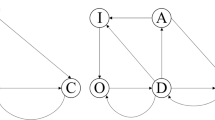Abstract
We develop a model of tax evasion based on the Ising model. We augment the model using an appropriate enforcement mechanism that may allow policy makers to curb tax evasion. With a certain probability tax evaders are subject to an audit. If they get caught they behave honestly for a certain number of periods. Simulating the model for a range of parameter combinations, we show that tax evasion may be controlled effectively by using punishment as an enforcement mechanism.
Similar content being viewed by others
References
Albert R, Barabási A-L (2002) Statistical mechanics of complex networks. Rev Modern Phys 74: 47–97
Aleksiejuk A, Hołyst JA, Stauffer D (2002) Ferromagnetic phase transition in Barabási–Albert networks. Physica A 310: 260–266
Allingham M, Sandmo A (1972) Income tax evasion: a theoretical analysis. J Public Econ 1(3–4): 323–338
Antunes L, Balsa J, Urbano P, Moniz L, Roseta-Palma C (2005) MABS 2005. In: Sichman JS, Antunes L (eds) Lecture Notes in Artificial Intelligence, vol 3891. Springer, Heidelberg, pp 147–181
Antunes L, Balsa J, Respício A, Coelho H (2007) MABS 2006. In: Antunes L, Takadama K (eds) Lecture Notes in Artificial Intelligence 3891. Springer, Heidelberg, pp 80–95
Bloomquist KM (2004) Multi-agent based simulation of the deterrent effects of taxpayer audits. In: Paper presented at the 97th annual conference of the National Tax Association, Minneapolis, November
Bloomquist KM (2006) A comparison of agent-based models of income tax evasion. Soc Sci Comput Rev 24(4): 411–425
Davis JS, Hecht G, Perkins JD (2003) Social behaviors, enforcement and tax compliance dynamics. Account Rev 78(1): 39–69
Föllmer H (1974) Random economies with many interacting agents. J Math Econ 1(1): 51–62
Korobow A, Johnson C, Axtell R (2007) An agent-based model of tax compliance with social networks. Natl Tax J 60: 589–610
Mittone L, Patelli P (2000) Imitative behaviour in tax evasion. In: Stefansson B, Luna F(eds) Economic simulations in swarm: agent-based modelling and object oriented programming.. Kluwer, Amsterdam, pp 133–158
Schnegg M (2006) Reciprocity and the emergence of power laws in social networks. Int J Mod Phys C 16: 1067–1077
Slemrod J (2007) Cheating ourselves: the economics of tax evasion. J Econ Perspect 31: 25–48
Stauffer D, Hehl FW, Winkelmann V, Zabolitzky JG (1988) Computer simulation and computer algebra: lectures for beginners. Springer, Heidelberg
Zaklan G, Lima FWS, Westerhoff F (2008) Controlling tax evasion fluctuations. Physica A 387:5857–5861; A multi-agent-based approach to tax morale. Int J Modern Phys C, Physics eprint 0508.0098 at http://www.arXiv.org
Author information
Authors and Affiliations
Corresponding author
Rights and permissions
About this article
Cite this article
Zaklan, G., Westerhoff, F. & Stauffer, D. Analysing tax evasion dynamics via the Ising model. J Econ Interact Coord 4, 1–14 (2009). https://doi.org/10.1007/s11403-008-0043-5
Received:
Accepted:
Published:
Issue Date:
DOI: https://doi.org/10.1007/s11403-008-0043-5




